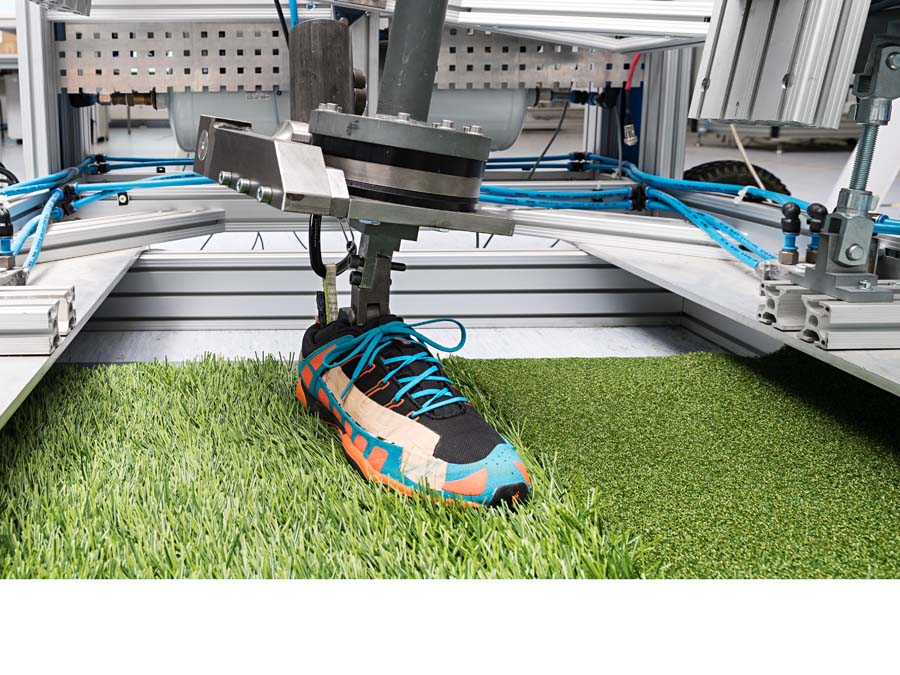Researchers test the performance of sports footwear
The perfect soccer boot

Choosing the optimal boot is as important to a soccer player as choosing the right tyres is to a racing driver. "Power from foot to surface and ball is transferred through the boot," explains Prof. Veit Senner. On the one hand, the boot must transfer to the surface all of the typical movements that a sportsperson might attempt, such as sprints, turns and feints, with minimum loss and without affecting the pronation of the foot. On the other hand, however, the boot must also transfer as much energy as possible to the ball.
These requirements cause conflicts and this affects the design of the boot: a stiff sole helps to transfer more energy when contact is made with the ball. In addition, the stiffness of the sole prevents the foot from deforming when you shoot and the studs from pressing against the insole. On the other hand, it is precisely this stiffness which can impair the pronation of the foot and also the lossless transfer of movements to the surface.
Risk of injury by knee locking
The challenges faced by the boot change depending on the type of playing surface, for instance, natural or artificial grass (AstroTurf), dry or wet pitch. For example, longer studs may provide more stability when the pitch is wet but they dig deeper into the ground. This means that players must use more power to execute certain movements, especially when it comes to sprints and quick changes of direction.
This also increases the risk of the knee becoming locked. Here the studs are planted firmly in the surface. The player tries to turn but the foot cannot follow this movement. "As a result, the knee is subjected to rotation loads," explains Senner. Worst-case scenario, this can cause a cruciate ligament injury – an injury that Antonio Rüdiger picked up only a few days ago during the German national team’s first training session in France.
However, it is not just the playing surface that the boot should be optimally adapted to; how you connect with the material of the ball is also crucial. Players also often like to transfer torque to the ball when shooting. Therefore, in addition to having good technique, the connection between the instep of the boot and the ball is vital.
Biomechanical testing device with a silicon foot
Together with his employees, Senner is testing, among other things, the optimal stiffness and the stud design of the boot whilst taking into account the playing surface. The researchers have developed a biomechanical testing device, equipped with an artificial silicon foot - the so-called TrakTester. The equipment has a piston which is operated using air pressure. Its task is to transfer the corresponding force to the foot. Attached below the piston is an artificial ankle whose axes are modelled on the human anatomy. A thick strap to represent the Achilles tendon is attached to the heel. The foot can be manoeuvred into a variety of positions that are typical to athletic movements and put to the test as part of the experiment. A multi-component measuring cell registers the force and torque delivered to the leg.
The mechanical simulation also behaves realistically with regard to the distribution of pressure in the foot: for example, if the player pushes off from his toes, high pressure is registered in the forefoot. "This process allows us to measure the performance of the boot and also the risk potential for knee injuries indirectly," explains Senner.
3D modelling of the motion sequence
Digital modelling supports the process. The scientists analysed, for example, television recordings of soccer matches in which players picked up knee injuries. They modelled the motion sequence in 3D to be able to understand the strain on the leg in visual terms.
The TrakTester can then be used to ascertain the stress applied to the lower leg. To determine the risk potential for the knee, the corresponding forces are applied to a knee simulator, also developed by Senner's group. Here the researchers can measure how these forces are transferred to the individual structures of the knee. Various degrees of muscle tension are also taken into account. Senner: "In this way, the conflict of objectives between optimal traction properties and injury prevention can be solved using systematic research."
Contact:
Prof. Veit Senner
Technical University of Munich
Department of Sports Equipment and Materials
Tel. +49 (89) 289 - 15364
senner@tum.de
www.lfe.mw.tum.de
Images for download: mediatum.ub.tum.de